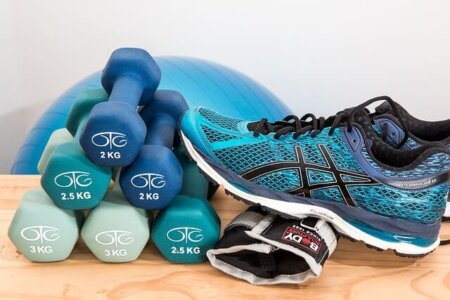The push-up is a traditional bodyweight exercise with a long history. While it’s challenging to pinpoint an exact date of origin, push-ups have been a part of physical fitness routines for centuries.
The push-up has been used in various forms in different cultures and training methods. It’s a fundamental bodyweight exercise that doesn’t require any equipment, making it accessible to people across different time periods and regions.
The concept of using one’s body weight to build strength and endurance has likely been practiced in different forms for as long as humans have been engaging in physical training. The push-up, in its basic form, has been a staple in military training and physical education for a considerable amount of time.
The modern push-up, as we know it today, has evolved and been standardized over the years. It has become a widely recognized and practiced exercise for building upper body strength, particularly in the chest, shoulders, and triceps.
Push-ups are one of the most well-known and widely practiced exercises that offer numerous benefits for overall fitness. Here are some reasons why push-ups are considered a valuable exercise:
Upper Body Strength: Push-ups primarily target the muscles in the chest, shoulders, and triceps. They help build and tone the muscles in the upper body.
Core Engagement: While performing push-ups, the core muscles are actively engaged to maintain a straight body position. This contributes to improved core strength and stability.
No Equipment Needed: Push-ups are a bodyweight exercise, meaning they require no equipment. This makes them accessible and convenient for people to do anywhere, anytime.
Versatility: Push-ups can be easily modified to suit different fitness levels. Beginners can start with wall push-ups or incline push-ups, while more advanced individuals can perform variations like diamond push-ups or one-arm push-ups.
Functional Fitness: The pushing motion involved in push-ups mimics many real-life activities, making them a functional exercise that can improve everyday physical tasks.
Compound Movement: Push-ups are a compound exercise, meaning they work multiple muscle groups simultaneously. This makes them an efficient way to target multiple areas of the body in one exercise.
While push-ups are beneficial, a well-rounded fitness routine should ideally include a variety of exercises to address different muscle groups and aspects of fitness. It’s important to combine strength training, cardiovascular exercise, flexibility work, and other forms of physical activity for overall health and fitness.
A push-up is a common strength-training exercise that primarily targets the muscles in the chest, shoulders, triceps, and core. Here’s how to perform a basic push-up:
Starting Position:
Begin in a plank position with your hands placed slightly wider than shoulder-width apart.
Your body should form a straight line from head to heels.
Execution:
Lower your body toward the ground by bending your elbows.
Keep your body in a straight line and avoid sagging or arching your back.
Lower yourself until your chest nearly touches the ground.
Return to Starting Position:
Push through your palms to straighten your arms and return to the starting position.
Keep your body straight throughout the entire movement.
Here are some tips for proper form:
Engage your core muscles to keep your body straight.
Keep your elbows close to your body as you lower and raise yourself.
Focus on controlled movements rather than speed.
Breathe in as you lower your body, and exhale as you push back up.
Push-ups are a versatile exercise and can be modified based on fitness level. They are an effective bodyweight exercise that helps improve upper body strength, endurance, and core stability.
While push-ups are a highly effective exercise, there are several reasons why some people may not incorporate them into their fitness routines as much as they could:
Perceived Difficulty: Push-ups can be challenging, especially for beginners. Some individuals may find them difficult to perform initially, and the perception of difficulty might discourage them from including push-ups in their workouts.
Lack of Knowledge: Some people may not be aware of the benefits of push-ups or how to perform them correctly. Lack of knowledge about proper form and modifications can make individuals hesitant to include push-ups in their routines.
Pre-existing Conditions or Injuries: Individuals with certain health conditions or injuries may find push-ups uncomfortable or unsuitable. In such cases, it’s essential to consult with a healthcare professional or fitness expert to determine suitable alternatives.
Preference for Other Exercises: People have different preferences when it comes to exercise. Some may prefer activities like running, cycling, or weightlifting over bodyweight exercises like push-ups. Variety in workouts is essential to keep individuals engaged and motivated.
Limited Time or Space: Some individuals may perceive push-ups as time-consuming or may feel they need a specific environment to perform them. However, push-ups can be done quickly and without the need for special equipment, making them a convenient option.
Perceived Ineffectiveness: Some people may believe that push-ups are not as effective as other exercises for achieving their fitness goals. This misconception may lead them to choose alternative exercises.
Inability to Track Progress: Unlike weightlifting exercises where individuals can easily track progress by increasing the amount of weight lifted, progress with push-ups may be less apparent. This lack of perceived progress can demotivate some individuals.
Despite these reasons, push-ups remain a highly valuable and accessible exercise. Proper education on their benefits, variations, and modifications, as well as addressing any concerns or misconceptions, can help encourage more people to include push-ups in their fitness routines.
The science behind a push-up involves the activation of various muscles and joints in the body. Here’s a breakdown of the key aspects:
Muscles Involved:
Primary Muscles:
Pectoralis Major (chest)
Deltoids (shoulders)
Triceps Brachii (back of the arms)
Secondary Muscles:
Serratus Anterior (along the sides of the chest)
Rectus Abdominis (abs)
Obliques (side abdominal muscles)
Transverse Abdominis (deep core muscles)
Rhomboids (upper back)
Latissimus Dorsi (lats)
Erector Spinae (lower back)
Joint Movement:
Shoulder Flexion/Extension: The shoulder joint moves as you lower and raise your body.
Elbow Flexion/Extension: The elbow joint bends and straightens as you lower and raise your body.
Core Activation:
The core muscles play a crucial role in stabilizing the body throughout the movement, preventing excessive arching, or sagging of the back.
Energy Systems:
Push-ups primarily engage the anaerobic energy system, as they involve short bursts of intense effort. However, they also contribute to overall cardiovascular fitness.
Neuromuscular Adaptations:
Regular practice of push-ups leads to neuromuscular adaptations, improving the efficiency of the nervous system in recruiting and coordinating muscle fibers.
Progressive Overload:
To see continued benefits, it’s essential to progressively overload the muscles, either by increasing the number of repetitions, changing hand positions, or introducing variations like incline or decline push-ups.
Hormonal Response:
Like many forms of exercise, push-ups can stimulate the release of endorphins, promoting a sense of well-being. They also contribute to increased growth hormone production, which is essential for muscle repair and growth.
Bone Health:
Weight-bearing exercises like push-ups have a positive impact on bone density, contributing to overall bone health.
Understanding the science of a push-up helps individuals tailor their workouts to achieve specific fitness goals, ensures proper form to prevent injuries, and provides insight into the broader benefits of this fundamental exercise in promoting overall health and strength.
Push-ups are a compound exercise that engages multiple muscle groups, making them effective for targeting various areas of the body. Here are the primary muscle groups that push-ups work:
Chest (Pectoralis Major): Push-ups are known for targeting the chest muscles. They work the pectoralis major, contributing to the development and toning of the chest.
Shoulders (Deltoids): The deltoid muscles in the shoulders are actively engaged during push-ups, especially during the lowering and pushing phases.
Arms (Triceps Brachii): The triceps, located at the back of the arms, are heavily involved in the extension of the elbow during the upward phase of a push-up.
Core Muscles:
Rectus Abdominis: The rectus abdominis, or the “six-pack” muscles, is engaged to stabilize the body during the movement.
Obliques: The oblique muscles on the sides of the abdomen help maintain torso stability.
Back Muscles:
Rhomboids: These muscles, located in the upper back, are engaged during the retraction of the shoulder blades.
Latissimus Dorsi: The lats, located on the sides of the back, are involved in shoulder extension.
Serratus Anterior: Located on the sides of the chest, the serratus anterior is engaged during the pushing phase, contributing to shoulder stability.
Legs and Hip Muscles:
Quadriceps: The quadriceps muscles in the front of the thighs help support the lower body.
Hip Flexors: The hip flexors are engaged to maintain a straight body position during the exercise.
Stabilizer Muscles:
Transverse Abdominis: The deep core muscles, including the transverse abdominis, are activated to provide stability.
Erector Spinae: These muscles along the spine help maintain proper spinal alignment.
While push-ups primarily focus on the upper body, they engage multiple muscle groups throughout the body, making them a comprehensive exercise for overall strength and stability. Additionally, variations of push-ups, such as wide grip, narrow grip, decline, or one-arm push-ups, can target specific muscle groups to a greater extent.
A push-up and a plank are both bodyweight exercises that engage different muscle groups and emphasize different aspects of fitness. Here are the key differences between a push-up and a plank:
Push-Up:
Starting Position:
Begins in a plank position, with hands placed slightly wider than shoulder-width apart.
The body forms a straight line from head to heels.
Movement:
Involves bending the elbows to lower the chest toward the ground.
Emphasizes the push phase to return to the starting position.
Muscles Targeted:
Primarily targets the chest (pectoralis major), shoulders (deltoids), and triceps.
Engages the core muscles for stabilization.
Dynamic Exercise:
Push-ups involve a dynamic movement, requiring both concentric (muscle shortening) and eccentric (muscle lengthening) contractions.
Intensity:
Can be modified for different fitness levels by adjusting hand positions or performing variations like incline or decline push-ups.
Plank:
Begins in a prone position, resting on the forearms and toes.
The body forms a straight line from head to heels, with elbows positioned directly under the shoulders.
Involves holding a static position without any up-and-down movement.
Muscles Targeted:
Primarily targets the core muscles, including the rectus abdominis, obliques, and transverse abdominis.
Engages muscles in the shoulders, back, and legs for stabilization.
Isometric Exercise:
Planks are isometric, meaning they involve static muscle contractions without changing the length of the muscle.
Intensity:
The intensity of a plank is determined by the duration of the hold. Variations, such as side planks or plank with leg lifts, can increase difficulty.
Dynamic vs. Isometric: A push-up involves dynamic movement, whereas a plank is an isometric exercise.
Primary Muscle Emphasis: Push-ups primarily target the upper body (chest, shoulders, triceps), while planks focus more on the core muscles.
Movement vs. Hold: Push-ups involve a series of movements (up and down), while planks involve holding a static position.
Both push-ups and planks are valuable exercises that can be incorporated into a well-rounded fitness routine. They complement each other, targeting different muscle groups and aspects of strength and stability. Incorporating both into a workout routine can provide a comprehensive approach to upper body and core training.
GETTING STARTED
If you’re new to push-ups or haven’t done them for a long time, it’s important to start gradually and focus on building strength and proper form. Here’s a step-by-step guide on how to begin doing push-ups:
Assessment:
Start by assessing your current fitness level and any potential limitations or injuries. If you have any concerns, it’s advisable to consult with a healthcare professional before beginning a new exercise routine.
Stand facing a wall at arm’s length.
Place your hands on the wall at shoulder height.
Lean forward, bending your elbows to bring your chest toward the wall.
Push back to the starting position.
Find a sturdy elevated surface, such as a bench, table, or sturdy countertop.
Place your hands on the elevated surface, slightly wider than shoulder-width apart.
Lower your chest toward the surface by bending your elbows.
Push back to the starting position.
Start on your hands and knees.
Position your hands slightly wider than shoulder-width apart.
Lower your chest toward the floor by bending your elbows.
Push back to the starting position.
Start in a plank position with your hands placed slightly wider than shoulder-width apart.
Keep your body in a straight line from head to heels.
Lower your chest toward the ground by bending your elbows.
Push back up to the starting position.
Body Alignment: Maintain a straight line from head to heels throughout the movement.
Hand Placement: Place your hands slightly wider than shoulder-width apart.
Elbow Position: Keep your elbows close to your body as you lower and raise yourself.
Core Engagement: Engage your core muscles to stabilize your body.
Frequency: Start with 2-3 sessions per week, allowing for rest days in between.
Repetitions and Sets: Begin with a manageable number of repetitions (e.g., 5-10) and gradually increase as your strength improves. Aim for 2-3 sets.
Progress Gradually: As you become more comfortable with push-ups, gradually progress from wall push-ups to incline push-ups, knee push-ups, and eventually full push-ups.
Pay attention to your body, and if you experience pain beyond normal muscle fatigue, consider adjusting the intensity or seeking guidance from a fitness professional.
Remember that consistency is key, and progress may take time. Gradually increasing the challenge will help you build strength and confidence in performing push-ups over time.
The number of push-ups a person should strive for to be in excellent shape can vary based on individual fitness levels, goals, and overall workout routine. It’s essential to focus on quality over quantity and to gradually progress to avoid overtraining and potential injury. Here are some general guidelines:
For Beginners:
Frequency: Start with 2-3 sessions per week, allowing for rest days in between.
Repetitions and Sets: Begin with a manageable number of repetitions, such as 5-10 push-ups per set.
Progress Gradually: Gradually increase the number of push-ups as your strength improves. Aim for 2-3 sets.
Intermediate to Advanced:
Frequency: Aim for 3-5 sessions per week, with rest days as needed.
Repetitions and Sets: Increase the number of repetitions per set as your strength improves. Aim for 10-25 push-ups per set.
Variations: Include variations like incline push-ups, decline push-ups, or one-arm push-ups to challenge different muscle groups.
Advanced Levels:
Frequency: Train 4-6 days per week with appropriate rest and recovery.
Repetitions and Sets: Perform higher repetitions per set, such as 20-50 push-ups or more.
Advanced Variations: Incorporate advanced push-up variations, such as clapping push-ups, explosive push-ups, or plyometric push-ups.
Considerations:
Individual Differences: Fitness levels vary among individuals, so what is excellent for one person may differ for another. Focus on your personal progress and goals.
Balanced Workout Routine: While push-ups are a valuable exercise, a well-rounded fitness routine should include other strength training exercises, cardiovascular activities, and flexibility work.
Listen to Your Body: Pay attention to your body’s signals. If you experience pain beyond normal muscle fatigue, consider adjusting the intensity or seeking guidance from a fitness professional.
Goal-Oriented Approach:
Instead of focusing solely on the number of push-ups, consider setting broader fitness goals such as improving overall strength, endurance, or achieving specific milestones. This approach can provide a more comprehensive and sustainable approach to fitness.
It’s also advisable to consult with a fitness professional to receive personalized guidance based on individual fitness levels, goals, and any specific considerations or limitations. Remember that consistency, proper form, and gradual progression are key factors in achieving and maintaining excellent physical shape.
If this helped you Share It!


















